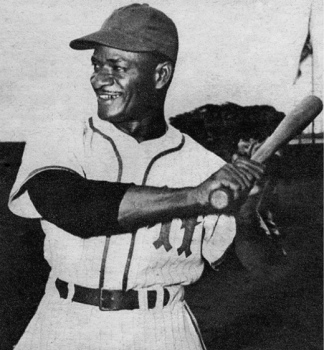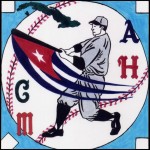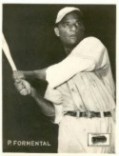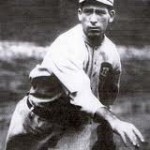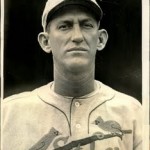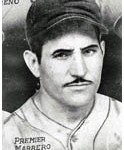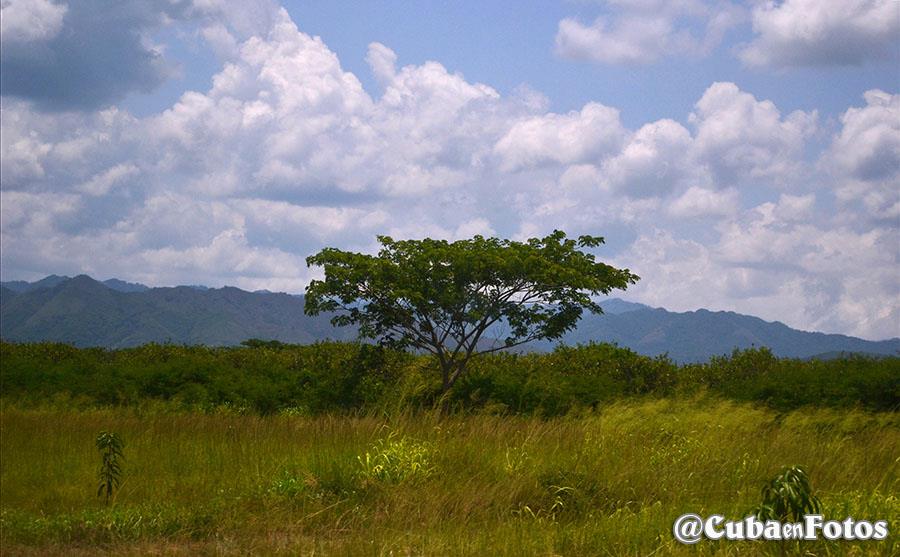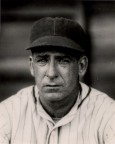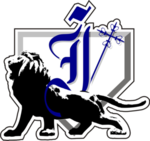PEDRO (Perucho/Perico) FORMENTAL.
Bats Left,
Throws Left
Height 5′ 11″,
Weight 200 lb.
Born April 19, 1915 in Baguanos Cuba
Pedro Formental sentence: “They call me Perico 300” became so popular that many began to call him by that nickname. Especially after they won the championship of the Cuban League in hits during the tournament from 1949-50 with a .336 average, wearing the uniform of the Habana Reds.
Formental who batted and threw left-handed, was born on April 19, 1915 in Central Maccabee, Banes, Oriente Province.
He started playing with the team in 1939 Baguanos Central until 1941. In 1942 it did in the semipro league with ‘La Pasiega’. That same year he debuted in the Cuban Winter League with club Cienfuegos until 1945-46 season was transfered to the Lions and went to Havana, where he played until part of the 1953-54 season, which ended with Club Mariano. However, went back the next year with the Havana Reds led by Miguel Angel Gonzalez.
His totals in 13 years and 678 in the pros Creole were .274 for average, 746 hits in 2.720 at-bats, including 431 runs, 106 doubles, 47 triples and 56 homers, the most connected by a left handed in the history of the circuit. The top place for a right-handed hitter belongs to Rafael Noble who shot 71 in 15 seasons.
Perucho finished his career tied with Alejandro Crespo, like the best boosters with 362, but subsequently increased Noble’s record to .372. Formental set a record for RBIs with 57 entries in 1952-53, which was tied by Rocky Nelson in 1954-55. His best batting average achievements in 1949-50 (.336) and 1952-53 (337).
From 1943 to 1946 asserted his nómbrate of “Perico 300” in the Mexican League where he hit at a rate of 312 (1943), 345 (1944), 362 (1945) and 384 (1946), wearing flannel of Tampico (1943), Veracruz (1944-45) and San Luis Potosi (1946). Its total land in the Aztec was .345 in four championships and 304 .
He played for several years with the Memphis Red Sox (1947-50), in the Negro Leagues in the United States, where he earned his best averages in 1949 (341) and 1950 (363).
In the summer of 1954 and 1955 , moved to the Cuban Sugar Kings of the International League, Triple A, with which it ended with identical .293 batting average of. He also played during the winter in Venezuela and the Dominican Republic, where he led all sluggers with 13 homers in 1951 and “slugging” to .704.
Participated in three consecutive Caribbean Series with Havana. In 1951 in Caracas, Venezuela, Panama in 1952 and 1953 in Havana. Homered in the first one and won the crown of the batters in the last, where rival pitchers abused by connecting to .560 for average product of 14 hits in 25 at-bats. Perucho murdered particularly pitchers from Venezuela, who bombardment hitting 4-4 on both occasions they were facing.
In Formental include many anecdotes and one of them is that playing for the Negro League Memphis, went to eat at a white restaurant in Dallas, Texas and when he refused entry, he took a Cuban passport and put a “tantrum father and my dear sir. ” You can imagine that they had to quit eating. Among other things Formental said: “You can discriminate against black Americans, but I’m Cuban and we’re not allowed to discriminate anyone in the world.”
On another occasion, after taking the championship in 1949-50 hitters, he ran for representative Unitary Action Party (PALJ) of Fulgencio Batista, and went on a tour of the province of Oriente in front of a selection called “Formental Stars.” It included the likes of John “Austral Parakeet” Delis, Homeric Soto, Cheito Bustamante, Amado Ibanez and others. But the fact is that not possible to conclude a scheduled challenge in Central Baguanos, located on the northeast coast due to heavy rains, had to stay in San Luis, where the narrator of the then California Angels in the AL, Ulpian Cos Villa, who then played with local teams that people gave him the idea of playing in nearby Palma. They moved to that place where you got Cos freely cede the ground of Club Deportivo Palma. Cos then conducted a promotion, from 9 am to 12 noon, crossing the city in a truck with a loudspeaker to announce the collision between a combination of people against the Stars Formental.
Perucho When he learned that the club would not pay their tickets for free admission for giving the field, refused to play. Finally came to realize the situation, not without its “ego” did say: “This time is fine, but in the next, all partners as well as the audience will have to pay to see in action Three hundred Perico. ”
Formental’s Cuban stardom really began in 1949-1950, when he hit .336 and slugged .468. He led the league in average, hits (99) and runs (51) and joined and Don Lenhardt on the All-Star outfield. Fermin Guerra beat him for MVP honors. That summer, Formental played his last season in the Negro Leagues. He did not like playing in the USA due to the discrimination there; once he dined in a white restaurant in Dallas, TX to flagrantly show his disapproval.
Pedro hit .250 and slugged .408 for Habana in 1950-1951; he led the CWL with 55 walks and tied for the lead with eight home runs. In the 1951 Caribbean Series, Formental hit .316 and slugged .632; he had 5 RBI in six . The veteran flyhawk hit .254 and slugged .417 in the 1951-1952 campaign. He led the loop with 47 runs and 46 RBI and tied Jim Basso for the lead with nine homers. He joined Frank Carswell and Sandy Amoros on the All-Star outfield. Bert Haas took home MVP honros instead.
Formental was only 1 for 16 with a double, 2 runs and five RBI in the 1952 Caribbean Series. At age 37, he had a career year in 1952-1953, hitting .337 and slugging .544. He led the league in doubles (18), tied Felipe Montemayor for the most walks (50), was second to Lou Klein with 10 home runs and set a new league record with 57 RBI. He joined Amoros and Minnie Minoso on the All-Star outfield. Minoso took MVP honors that time.
In the 1953 Caribbean Series, Formental set a Caribbean Series record with 14 hits (in 25 AB). He had 20 total bases and 8 RBI as Havana fell shy of a title.
Formental’s decline then began as he was certainly getting old for a hitter. He batted .258 and slugged .373 in 1953-1954, spending part of the winter with Marianao. In 1954, he hit .293/?/.477 for the AAA Havana Sugar Kings, leading the club in slugging; most of his teammates would play in the majors at some point.
In 1954-1955, Formental hit .292 and slugged .482 for the Havana Lions. For the ’55 Sugar Kings, Pedro batted .293/?/.433, .002 behind team slugging leader Clint Hartung. It was the curtain call for Formental, who wrapped up with better play after age 35 than before age 30.
Formental was a strong supporter of Cuban dictator Fulgencio Batista.
Overall, Formental finished 7th in Cuban Winter League history in at-bats (2,720), 4th in runs (431), 5th in hits (746), tied for fifth with Ray Noble in doubles (106), third in triples (47, behind Hector Rodriguez and Minoso), 4th in home runs (56, behind Noble, Minoso and Ortiz) and 8th in RBI (362).
In 304 in the Mexican League, Formental had hit .345/~.465/.524.
Formental was later inducted into both the Cuban Baseball Hall of Fame and Caribbean Baseball Hall of Fame. After that all information we have is this notice Pedro FORMENTAL – U.S. Social Security Death Index Birth: 17 Apr 1919 – State Where Number was Issued: Tennessee Death: 15 Sep 1992.
Source: Baseball.com/Wiki/InternetPhotos/TheCubanHistory.com
Pedro (Perucho) Formental
The Cuban History, Arnoldo Varona, Editor
CUBANS IN BASEBALL
Always when we are getting close to a day like Cuba’s Independence day (20th of May) think of the contribution made for the Cuban baseball in relation to the struggle for the freedom of Cuba. Because of the war for independence, many ball players didn’t participate in any championships and others changed the bat for the machete to help the armed struggle.
Former manager and player , died in exile in the Spanish missions of Ceuta, almost all Cuban children playing baseball in Key West, sailed to the island to fight as members of the expedition of General Nuñez, who landed in Palo Alto.
This occurred long before the freedom of Cuba and when no one knew of the existence of baseball, Esteban Bellan became in 1871 the first player abroad, Cuban and Latin American to play in the majors and since that time showed the world who were the pioneers, followed by Sandy Nava in 1882.
Although you are not interested world of sports you have to know that sportswriters, for ignorance or malicious intentions, keep saying that the Colombian Luis Castro (who by the way was from Venezuela) was the first Latin American player in large circuits, but in the modern era of baseball.
Between the late 19’s and early 20’s, the Cubans taught the sport of balls and strikes in Mexico and the Caribbean, including Venezuela, Dominican Republic and Puerto Rico, with the exception of Panama. Now we are in the doldrums because of our political problem, but what nobody can take away is that we were the first in almost all lines of play.
Adolfo Luque was the first to participate and get a win in the Fall Classic and in the Amateur World Series and Caribbean Series, where we won the last five consecutively.
Only because the Cuban misgovern in our island, we would be for years in the major league of the US, because the Cuban Sugar Kings (Cubans Sugar Kings) of the International League in the Triple A, were appointed to integrate the major leagues before that Montreal and Toronto, under the slogan: “One more step and reach.” 50 years have passed and no other Latin American country has achieved a qualifying team Triple A.
Cubans ball players who has been in higher circuits through history never have been because the product of any political system, but the heritage of the players of yesteryear such as , who won 27 in 1923 season with the Reds Cincinnati, the most ever for a Latin American pitcher and Jose de la Caridad Mendez, who hung 25 zeros to the Cincinnati Reds, Eustaquio “Bowler” Pedroso, who pitched a no-hit innings against the Detroit Tigers in 1909 and John Eckelson Decall Juanito, who remain true amateurs beat the Boston Red Sox and New York Giants, respectively. Rodolfo Fernandez defeated three major league teams who are faced, as did the lefty Agapito Mayor twice, as did Ramon Bragana, Basil “El Brujo” Rosell, Julio “The Jiqui” Moreno, Conrado “The Premier” Marrero, Silvino Ruiz and others who played ninth largest circuit in Cuba.
Miguel Angel Gonzalez (tentatively) and Preston Gomez (official), were the first American to lead major league sets, Minnie Minoso and Marrero, first along the Venezuelan Alfonso “Chico” Carrasquel, to participate in an All-Star Game; Sandalio ” Potrerillo “Consuegra the first champion of American League pitchers, Camilo Pascual, the first striking out 15 batters in a challenge and win 20 in two consecutive years, Tony Oliva, the first to conquer the crown of the batsmen in their first two seasons, Bert Campaneris the first to play all nine positions in a game, Zoilo Versalles the first to be selected MVP of the AL and also integrate with Tony Oliva and three players from the Minnesota Twins, the first quintet scored five runs in one inning., Luis Tiant the first to strike out 19 batters, as well as recorded the first shutout in a Fall Classic to win by the southpaw Mike Cuellar, a whopping 20 four times different, Tony Perez, first to hit three homers in a World Series, Martin Dihigo, only to be elected to the Halls of Fame of four countries (Cuba, Mexico, USA and Venezuela), Jose Canseco, first to hit 40 homers and steal 40 bases, in addition to being the first foreigner to reach the 400 films in four corners. All this for only mention a few achievements.
In 1950, when Witt Aloma, Sandalio Consuegra, , Limonar Martinez, Julio Pascual Moreno and Patato Pascual came to the Great Circus, the group of Cubans from 1871 to that date was 51, against only 10 players from other countries: a Colombian (Luis Castro), three Venezuelans (Alejandro “Paton” Carrasquel, Jesus “Chucho” Ramos and Alfonso “Chico” Carrasquel), four Mexicans (Melo Almada, José Luis “Chile” Gomez, Jesse “El Guero” Flowers and Beto Avila), two Puerto Rico (Hiram Bithorn and Luis Rodriguez Olmo). All this without counting the black Cuban stars who could not play for then descrimination as Jose Mendez, Alejandro Oms, Silvio Garcia, Garcia and dozens more that would have doubled or tripled the amount.
To give you an idea of domain of our natives, I would say that when the first Dominican, Ozzie Virgil in 1956 (almost a century after Bell) debuted in the Big Leagues, already had marched 71 Cuban baseball players by Major League, when it was difficult give him opportunities to foreign players, especially since there were only 16 teams and not 30 as now.
In 1967, the first major invasion of Latin American players in the majors, 37 in the NL and 36 in the AL, because they could not get players from Cuba. Despite eight years after the arrival to power of the Castros tyranny, Cubans still dominated the scene with 30, followed by Puerto Rico with 11, Dominican Republic and Venezuela (9), Panama (8) and Mexico 6.
Cubans dominate with four of the nine members of the Hall of Fame in Cooperstown Baseball (Martin Dihigo, Tony Perez, Jose Mendez, Cristobal Torriente), despite the injustice that was committed with Luque, Oliva, Tiant, Minoso and Silvio Garcia, who was chosen before Jackie Robinson, breaking the color barrier with the Brooklyn Dodgers, but was removed by his intolerant Latin temperament.
If not for the totalitarian system that has tyrannized Cuba for 50 years, the Cuban players would dominate, as they always have since 1871. In the irreparable damage that the island has suffered, we must add baseball.
Can you imagine the talent that would had developed Cuba since 1961, to have had baseball academies like the one created by the Cuban Rafael Avila in the Dominican Republic instead of his country.
Remember that we Cuban have baseball in our blood, something that atheistic communism couldn’t take from us, the old Cuba always played the best ball, as in Brazil with soccer, clarifying that the Sport is not an invention of the present. On the contrary, due to the lack of competition and teaching, the current players who escape the island, find it hard to get accustomed right away on the best baseball in the world, with honorable exceptions such as Orlando “El Duque” Hernandez for example.
In Memoriam of our always present Sportwriter Angel Torres 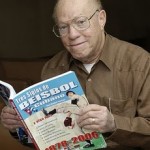
When the Spaniards wanted to impose to us love for football, saying it was the “Sport of Kings”, Cubans responded by saying that “baseball was the king of sports”.
Sources: AngelTorres/BaseballCuba/InternetPhotos/TheCubanHistory.com
Cubans in Baseball
The Cuban History, Arnoldo Varona, Editor
ROBERTO ORTIZ – “EL GIGANTE DEL CENTRAL SENADO”
He was born on Wednesday, June 30, 1915, in Camaguey, Cuba. It was the pelotero of more popularity in the history of baseball of Cuba ” The Gigante” of the central Senate as they called to him by to have been born in this place the 30 from June from 1917.
Ortiz was 26 years old when he broke into the big leagues on September 6, 1941, with the Washington Senators. It his life to baseball entirely and it personified a model of athlete; Ortiz began to play at “Hershey” playground where he started his race as Amateur player. Jose Cambria signed to him and he sent to him to the Charlote, where Robert began his life until professional. passed away in Miami on the 15 of September of 1971.
Birth Name: Roberto Gonzalo (Nunez) Ortiz
Nickname: None
Born On: 06-30-1915 (Cancer)
Born In: Camaguey, Cuba
Died On: 09-15-1971
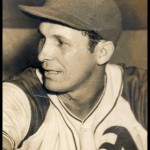
Died In: Miami, Florida
Cemetery: Flagler Memorial Park, Miami, Florida
High School: Undetermined
College: None Attended
Bats: Right
Throws: Right
Height: 6-04
Weight: 200
First Game: 09-06-1941 (Age 26)
Last Game: 09-02-1950
Draft: Not Applicable
Sources: Wiki/Rob.Ort.Cub/ InternetPhotos/TheCubanHistory.com
Roberto Ortiz “El Gigante del Central Senado”
The Cuban History, Arnoldo Varona, Editor
BASEBALL IN CUBA
Baseball was introduced to Cuba in the 1860s by Cubans who studied in the United States and American sailors who ported in the country. The sport quickly spread across the island nation. Nemisio Guillo is credited with bringing a bat and baseball to Cuba in 1864 after being schooled in Mobile, Alabama. Two more Cubans were sent to Mobile, one being his brother Ernesto; the Guillo brothers and their contemporaries formed a Baseball team in 1868 – the Habana Baseball Club. The club won one major match – against the crew of an American schooner anchored at the Matanzas harbour.
Soon after this, the first Cuban War of Independence against its Spanish rulers spurred Spanish authorities in 1869 to ban playing the sport in Cuba. The reasons were because Cubans began to prefer baseball to viewing bullfights, which Cubans were expected dutifully attend as homage to their Spanish rulers in an informal cultural mandate. As such, baseball became symbolic of freedom and egalitarianism to the Cuban people. The ban also prompted Esteban Bellán to join the semipro Troy Haymakers – he would became the first Latin American player to play in a Major League in the United States. Bellán had started playing baseball for the Fordham Rose Hill Baseball Club, while attending Fordham University (1863 – 1868). After that he played for the Unions of Morrisania, a New York City team. Bellán played for the Haymakers until 1872; in 1871 it joined the National Association.
The first official match in Cuba took place in Pueblo Nuevo, Matanzas, at the Palmar del Junco on December 27, 1874. It was between Club Matanzas and Club Habana, the latter winning 51 to 9, in nine innings.
In late 1878 the Cuban League was organized, consisting of three teams, Almendares, Habana, and Mantanzas. The season consisted of four per team. The first game was played on December 29, 1878, with Habana defeating Almendares 21 to 20. Habana, under team captain Bellán, was undefeated in winning the first championship. The teams were amateurs (and all whites), but gradually professionalism took hold as teams bid away players from rivals.
The Spanish-American War brought increased opportunities to play against top teams from the United States. Also, the Cuban League admitted black players beginning in 1900. Soon many of the best players from the Negro Leagues were playing on integrated teams in Cuba. Beginning in 1908, Cuban teams scored a number of successes in competition against major league baseball teams, behind outstanding players such as pitcher José Méndez and outfielder Cristóbal Torriente (who were both enshrined in the Baseball Hall of Fame in 2006). By the 1920s, the level of play in the Cuban League was superb, as Negro League stars like Willie Wells and John Henry Lloyd spent their winters playing in Cuba.

In the Minor leagues the Havana Cubans, Florida International League from 1946-53, and the Cuban Sugar Kings, International League 1954-1960, brought Cuban baseball to the mainstream in the United States.
Baseball Today in Cuba
Baseball is considered to be the national sport of Cuba, and the sport which most ordinary Cubans are passionate about. Cuba has a long history of playing this sport on the island which goes back to the 19th century. The national baseball team of Cuba is easily the best in Latin America and often dominates regional competitions in this sport. The national baseball league in Cuba is also well developed providing plenty of opportunity for players of this sport to improve their skills at the highest national levels in Cuba. Every province in Cuba has its own baseball team while Havana has two and Isla de la Juventud has another. This means there are a total of 16 baseball teams in the national baseball league. The sports season begins in early autumn and culminates with national finals in May. The sporting league is similar to the basketball league in the US where the best of the Eastern conference meets the best of the Western conference in the finals which are played as the best of a series of seven.
Everything has seemingly been positive, however not everything went as planned. Since the professional system was abolished in-favor of amateur leagues, players were not paid as extravagantly as they once were. One report found that most baseball stars made less than $2,000 annually and that all players would receive sports leave pay at the same rate they would get from their off-season jobs as engineers, sports instructors, handymen, etc. The situation would get worse in the early 1990s after the collapse of the Soviet Union in 1991, which was Cuba’s main trading partner. This led many players to defect to the United States due to deteriorating economic conditions. Amidst such action, even Fidel Castro admitted himself that it’s hard to prevent the baseball stars from defecting. He would later proclaim, “if you have to compete against six million dollars versus three thousand Cuban pesos you cannot win.” Other problems included bribery scandals in which coaches and player alike would fix , which subsequently led to them being banned from baseball in Cuba. Following the collapse of the Soviet Union, there were also instances in Cuba where baseball would be canceled due to power outages and most fans chose to watch from their home since it seemed more feasible to do so. The situation was so bad that pitchers in-game, would often have to exchange cleats with the pitcher who would have to pitch in the next half-inning.[25] As one can note, resources even as minute as baseball cleats were that scarce during this very time. The Cuban government to this very day is also somewhat hostile in relation to the players that did defect in the 1990s.
Esteban Enrique Bellan (1850 – August 8, 1932), also known as Esteban, or Steve Bellan (bel-lyahn), was credited as having been the first Latin American professional baseball player to play in the United States.
The Havana-born Bellan also became one of Cuba’s first great baseball player-managers, having learned how to play the game while he was a student at Fordham University from 1863-1868. As was common among wealthy Cuban-Catholic families, Bellan and his brother Domingo were sent to the United States to study at Fordham, a Jesuit institution. During his time at Fordham, he played for the newly created Fordham Rose Hill Baseball Club. Founded in the late 1850′s, the Rose Hill’s played the first ever nine-man team college baseball game in the United States against St. Francis Xavier College on November 3, 1859.
After being graduated in 1868, Bellan played for the Unions of Morrisania, who originated baseball in the Bronx and called themselves the “Champions of the World” around 1866. Morrisania played near the spot where the old Melrose station of the Harlem Railroad was located (Yankee Stadium was built in 1923 almost in the same place).
More than a half-century before Jackie Robinson broke baseball’s color barrier, the Troy Haymakers employed Bellan, a Latino player in a league which otherwise was entirely lily-white. Nicknamed “The Cuban Sylph” for his elegant and stylistic play at third base, Bellan played for the Haymakers from 1869-1872. The Haymakers in 1871 joined the nascent National Association, which was the forerunner of the National League in 1876. Later the Haymakers became the New York Gothams (1883-1884) and New York Giants (1885-1957), now the San Francisco Giants since 1958.
After his time with the Haymakers, Bellan played with the New York Mutuals in 1873, and then returned to his homeland. He compiled a personal record of a .252 batting average, with 69 hits, 52 runs scored, 42 runs batted in, 9 doubles, 3 triples and 5 stolen bases in 60 played.
From 1878-1886 Bellan served as both a player and manager for the recently founded Habana baseball team, playing in the first organized baseball game in Cuba on December 27, 1874. Club Habana defeated Club Matanzas, 51 to 9, in nine innings. Bellan led Habana to three Cuban baseball championships (1878-79, 1979-80, 1882-83). He was also inducted into the Fordham University Hall of Fame (1989-90).
Steve Bellan died on August 8, 1932 in Havana, Cuba. He was 82 years old.
Sources: Wiki/CubanPlayers/InternetPhotos/TheCubanHistory.com
Baseball in Cuba
The Cuban History, Arnoldo Varona, Editor





